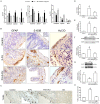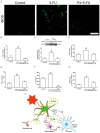5-Fluorouracil Induces Enteric Neuron Death and Glial Activation During Intestinal Mucositis via a S100B-RAGE-NFκB-Dependent Pathway
- PMID: 30679569
- PMCID: PMC6345953
- DOI: 10.1038/s41598-018-36878-z
5-Fluorouracil Induces Enteric Neuron Death and Glial Activation During Intestinal Mucositis via a S100B-RAGE-NFκB-Dependent Pathway
Abstract
5-Fluorouracil (5-FU) is an anticancer agent whose main side effects include intestinal mucositis associated with intestinal motility alterations maybe due to an effect on the enteric nervous system (ENS), but the underlying mechanism remains unclear. In this report, we used an animal model to investigate the participation of the S100B/RAGE/NFκB pathway in intestinal mucositis and enteric neurotoxicity caused by 5-FU (450 mg/kg, IP, single dose). 5-FU induced intestinal damage observed by shortened villi, loss of crypt architecture and intense inflammatory cell infiltrate as well as increased GFAP and S100B co-expression and decreased HuC/D protein expression in the small intestine. Furthermore, 5-FU increased RAGE and NFκB NLS immunostaining in enteric neurons, associated with a significant increase in the nitrite/nitrate, IL-6 and TNF-α levels, iNOS expression and MDA accumulation in the small intestine. We provide evidence that 5-FU induces reactive gliosis and reduction of enteric neurons in a S100B/RAGE/NFκB-dependent manner, since pentamidine, a S100B inhibitor, prevented 5-FU-induced neuronal loss, enteric glia activation, intestinal inflammation, oxidative stress and histological injury.
Conflict of interest statement
The authors declare no competing interests.
Figures






Similar articles
-
Vortioxetine attenuates rotenone-induced enteric neuroinflammation via modulation of the TLR2/S100B/RAGE signaling pathway in a rat model of Parkinson's disease.Neuropharmacology. 2025 Jun 15;271:110385. doi: 10.1016/j.neuropharm.2025.110385. Epub 2025 Feb 25. Neuropharmacology. 2025. PMID: 40010563
-
The involvement of mast cells in the irinotecan-induced enteric neurons loss and reactive gliosis.J Neuroinflammation. 2017 Apr 7;14(1):79. doi: 10.1186/s12974-017-0854-1. J Neuroinflammation. 2017. PMID: 28388962 Free PMC article.
-
Ameliorative Effect of Ginsenoside Rc on 5-Fluorouracil-Induced Chemotherapeutic Intestinal Mucositis via the PI3K-AKT/NF-κB Signaling Pathway: In Vivo and In Vitro Evaluations.Int J Mol Sci. 2024 Dec 5;25(23):13085. doi: 10.3390/ijms252313085. Int J Mol Sci. 2024. PMID: 39684797 Free PMC article.
-
S100B protein in the gut: the evidence for enteroglial-sustained intestinal inflammation.World J Gastroenterol. 2011 Mar 14;17(10):1261-6. doi: 10.3748/wjg.v17.i10.1261. World J Gastroenterol. 2011. PMID: 21455324 Free PMC article. Review.
-
Irinotecan- and 5-fluorouracil-induced intestinal mucositis: insights into pathogenesis and therapeutic perspectives.Cancer Chemother Pharmacol. 2016 Nov;78(5):881-893. doi: 10.1007/s00280-016-3139-y. Epub 2016 Sep 2. Cancer Chemother Pharmacol. 2016. PMID: 27590709 Review.
Cited by
-
The Intestinal Redox System and Its Significance in Chemotherapy-Induced Intestinal Mucositis.Oxid Med Cell Longev. 2022 May 9;2022:7255497. doi: 10.1155/2022/7255497. eCollection 2022. Oxid Med Cell Longev. 2022. PMID: 35585883 Free PMC article. Review.
-
Troxerutin Prevents 5-Fluorouracil Induced Morphological Changes in the Intestinal Mucosa: Role of Cyclooxygenase-2 Pathway.Pharmaceuticals (Basel). 2020 Jan 8;13(1):10. doi: 10.3390/ph13010010. Pharmaceuticals (Basel). 2020. PMID: 31936203 Free PMC article.
-
The S100B Inhibitor Pentamidine Ameliorates Clinical Score and Neuropathology of Relapsing-Remitting Multiple Sclerosis Mouse Model.Cells. 2020 Mar 18;9(3):748. doi: 10.3390/cells9030748. Cells. 2020. PMID: 32197530 Free PMC article.
-
The Alpha-Lipoic Acid Improves Survival and Prevents Irinotecan-Induced Inflammation and Intestinal Dysmotility in Mice.Pharmaceuticals (Basel). 2020 Nov 3;13(11):361. doi: 10.3390/ph13110361. Pharmaceuticals (Basel). 2020. PMID: 33152996 Free PMC article.
-
Clostridioides difficile infection promotes gastrointestinal dysfunction in human and mice post-acute phase of the disease.Anaerobe. 2024 Jun;87:102837. doi: 10.1016/j.anaerobe.2024.102837. Epub 2024 Mar 26. Anaerobe. 2024. PMID: 38527650 Free PMC article.
References
Publication types
MeSH terms
Substances
LinkOut - more resources
Full Text Sources
Miscellaneous

